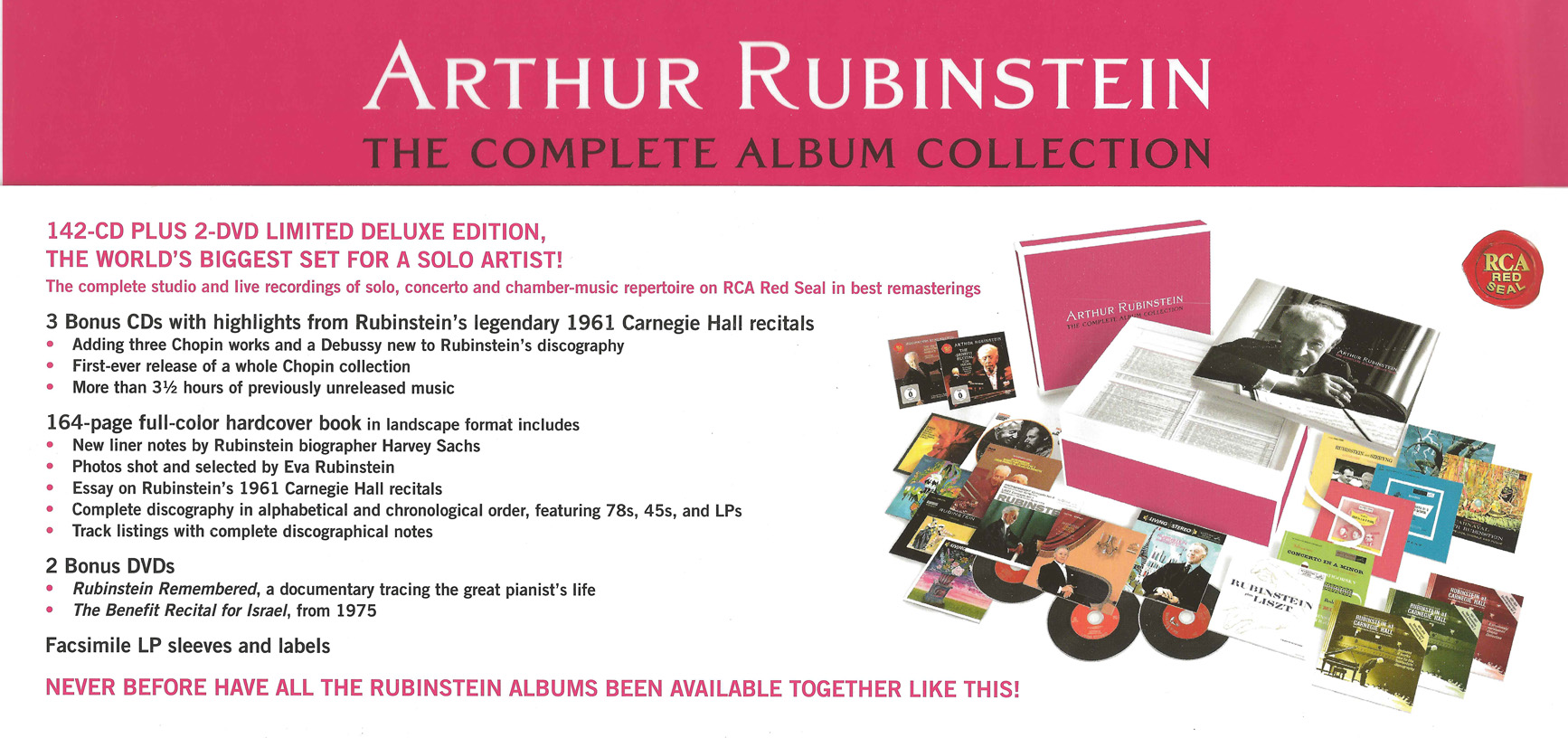Johann Sebastian Bach
Arranged for Piano by Ferruccio Busoni
Media Review / Listening Diary 2014-04-28
2014-04-28 — Original posting (on Blogger)
2014-11-11 — Re-posting as is (WordPress)
2016-07-20 — Brushed up for better readability
Table of Contents
Exploring the Fringes of Rubinstein’s Recording Repertoire…
Ferruccio Busoni: Transcription of Bach’s Chaconne for Violin Solo
My Listening Diary 2014-04-13 covered a first recording by Arthur Rubinstein: Ferruccio Busoni’s piano arrangement of Bach’s Toccata, Adagio & Fugue in C major, BWV 564 — and I included a short comparison with Bach’s original composition for organ. Here now is a second instance of Ferrucio Busoni (1866 – 1924) arranging one of Bach’s compositions for piano. This time, it’s the famous Chaconne, the last movement from the second Partita for violin solo in D minor, BWV 1004 by Johann Sebastian Bach (1685 – 1750), listed as BV B 24.
In this case, I won’t venture a comparison with Bach’s original. For one, this would be rather exhaustive, given the 18 versions for single, solo string instrument currently in my collection. More importantly, unlike in the case of BWV 564, this is not “just” a “translation” between two keyboard instruments (organ vs. piano), but rather one from solo violin to the concert grand.
Busoni does an excellent job at capturing the spirit of Bach’s masterpiece for solo violin, and Bach’s composition “survives” this translation amazingly well. However, with all the extra (rich) harmonizations, the bass doublings, the extra pathos in general, in the listener’s experience the result is miles away from Bach’s original (let alone recent, historically informed performances on the violin). Still, it’s an impressive piece for pianists to demonstrate their virtuosic abilities! Here are Rubinstein’s two recordings of this piece:
The CDs
Arthur Rubinstein Collection, CD #141
Arthur Rubinstein — The Complete Album Collection
CD #141: Rubinstein at Carnegie Hall — Recorded during the historic ten recitals of 1961
Busoni-Bach: Chaconne; Brahms: Piano sonata #3 op.5, Intermezzi op.117/2, 118/2 & 118/6
Chopin: Mazurka op.33/2, Nocturne op.27/2; Schubert: Impromptu D.899/4
Arthur Rubinstein
SONY Classical 88691936912 (142 CDs / 2 DVDs, mono / stereo); ℗ / © 2011
Documentation 162 pp., track listing on CD sleeve

Arthur Rubinstein Collection, CD #130
Arthur Rubinstein — The Complete Album Collection
CD #130: Franck: Prélude, Choral & Fugue; Bach-Busoni: Chaconne; Mozart: Rondo K.511
Arthur Rubinstein
SONY Classical 88691936912 (142 CDs / 2 DVDs, mono / stereo); ℗ / © 2011
Documentation 162 pp., track listing on CD sleeve

Rubinstein’s Interpretation
How does Arthur Rubinstein fare with this virtuoso piece? First: the two interpretations are substantially different! They may serve to explain why Rubinstein was selective in what he chose to record, and why he felt recordings to be so much different from live concerts.
This is not meant to deprecate recording performances. Rubinstein apparently felt at ease in the recording studio, and his studio performances are no worse than live events (quite to the contrary, maybe!). Rubinstein carefully selected the compositions he wanted to record. He would not give up on a recording session until he was 100% satisfied with the result. To his dismay (yet fortunately!), however, his interpretation of any piece continued to evolve; almost invariably he no longer liked his own recordings after a year or so! Some rudimentary comments on Rubinstein’s recordings:
- The first recording above is from a live concert at Carnegie Hall, in 1961. One can hear the occasional noise from the audience, and there is some low-frequency rumbling during parts of the performance, but in general, the sound (stereo) is OK. The tempo is fluent — occasionally at the fringe of being too fluent (it takes 12’50”, one of the fastest performances that I heard), yet virtuosic, clear.
- The second recording is from 1970. It’s a studio recording: the sound is better, fuller, warmer. The recording in general maybe a little less clear than the one from the concert. The tempo is more controlled and more stable, and a little slower overall (duration: 14’25”). The interpretation is definitely under more control, the technique impeccable. Keep in mind that Rubinstein was 83 at the time of this recording! This recording is also available on YouTube.
Comparing with Others
Overall, I really like both these recordings — but I don’t want to rate them, or at this point compare them to the many other recordings, other than stating that Rubinstein’s interpretations don’t need to hide from any of his contenders. Several interpretations can be watched or heard on YouTube, see below. This is not a comprehensive list; I just mention recordings that I listened into:
- Ferruccio Busoni‘s own performance (piano roll, part #2 to be found here), taking 7’51” + 7’31” (15’22”). This is full of rubato and romanticisms. I don’t think we know how much of the rubato is introduced by the piano roll recording mechanism, though. It’s hard to listen to by now, I think.
- Arturo Benedetti Michelangeli in a recording from 1949: an excellent performance (13’50”, the video is no longer available, unfortunately).
- Marc-André Hamelin in a live recording. The sound is not always perfect, but the playing technically pretty impeccable, as expected (14’25”)
- Alicia de Larrocha in a live performance from 1986 (14’41”)
- Evgeny Kissin, also live, 1996 (15’43”)
- Hélène Grimaud, live (14’59”, not my favorite performance, for sure).
Listening Diary Posts, Overview






